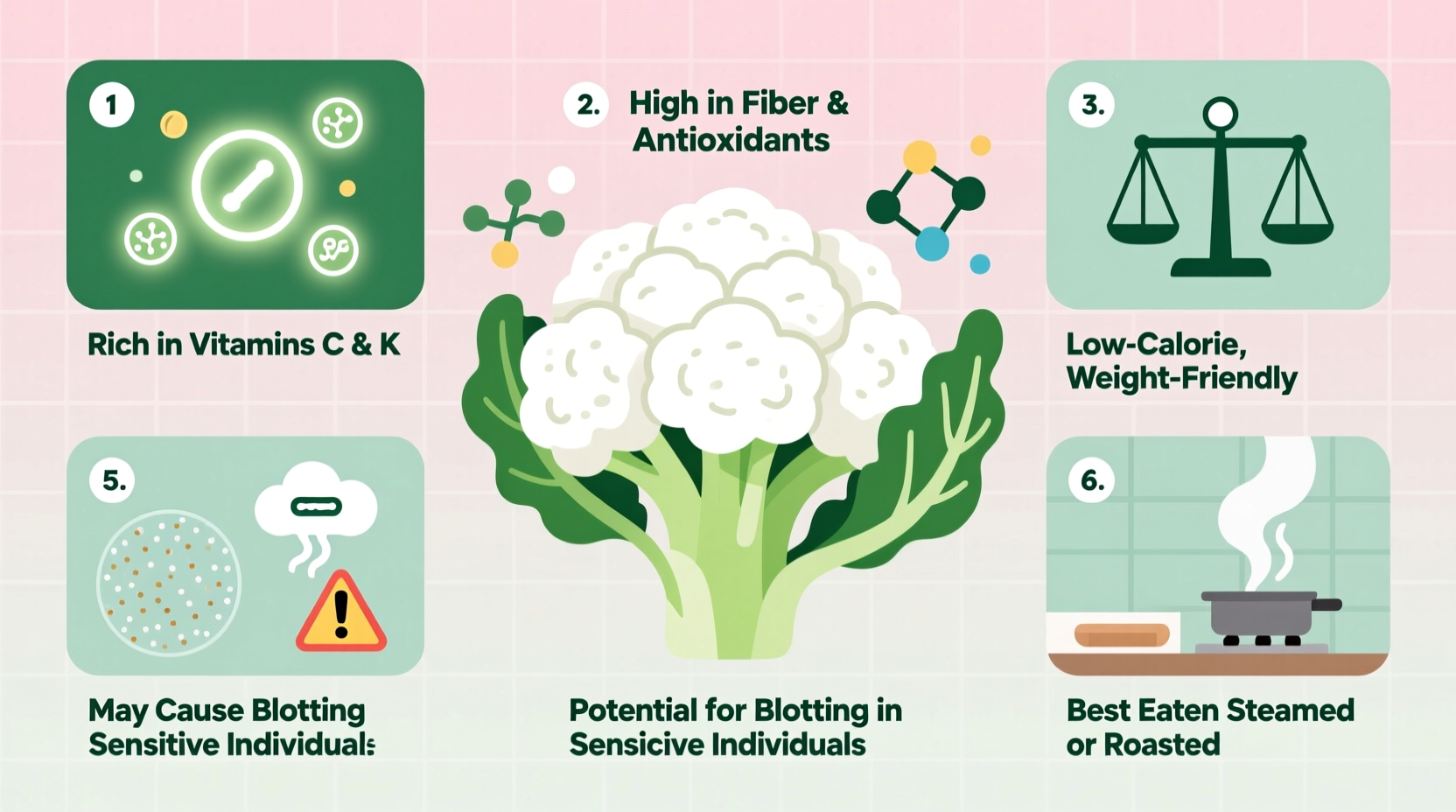Discover exactly how cauliflower impacts your health with this evidence-based analysis of its nutritional advantages and potential drawbacks. You'll learn practical strategies to maximize benefits while minimizing concerns, whether you're managing specific health conditions or simply making informed dietary choices. This guide cuts through the hype to deliver science-backed insights you can actually use.
Nutritional Profile: Why Cauliflower Stands Out
One cup (100g) of raw cauliflower packs impressive nutrition for just 25 calories, according to USDA FoodData Central. This cruciferous vegetable delivers 77% of your daily vitamin C needs, 20% of vitamin K, 10% of folate, and 3g of dietary fiber. Unlike many vegetables, cauliflower contains choline—a nutrient essential for brain health that 90% of Americans don't get enough of, as reported by the National Institutes of Health.
Science-Backed Health Advantages
Cauliflower's benefits extend far beyond basic nutrition. Research reveals several compelling advantages:
Cancer-Preventive Compounds
Cauliflower contains glucosinolates that convert to isothiocyanates during digestion—compounds shown to inhibit cancer cell development. A comprehensive review in Nutrients journal found regular cruciferous vegetable consumption correlates with 15-20% lower risk of certain cancers, particularly lung, colorectal, and prostate cancers. The American Institute for Cancer Research identifies cauliflower as one of the most potent cancer-fighting vegetables due to its sulforaphane content.
Heart Health Support
The fiber, potassium, and antioxidant profile in cauliflower contributes to cardiovascular protection. According to the American Heart Association, diets rich in cruciferous vegetables associate with lower blood pressure and reduced arterial stiffness. The vitamin K1 in cauliflower also helps prevent calcium buildup in arteries.

Weight Management Benefits
With only 25 calories per cup and high water content (92%), cauliflower provides volume without excess calories. Studies in the Journal of Nutrition show high-volume, low-energy-density foods like cauliflower increase satiety while reducing overall calorie intake. This makes it particularly valuable for sustainable weight management compared to higher-calorie alternatives.
| Key Advantages | Important Considerations |
|---|---|
| Rich in vitamin C (77% DV per cup) | May cause gas/bloating due to raffinose sugar |
| Contains cancer-fighting glucosinolates | Goitrogens may affect thyroid function in sensitive individuals |
| Excellent source of dietary fiber (3g/cup) | High FODMAP content may trigger IBS symptoms |
| Provides choline for brain health | Raw consumption causes more digestive issues than cooked |
Understanding Potential Drawbacks
While cauliflower offers numerous benefits, certain considerations matter for specific populations:
Digestive Sensitivity Explained
Cauliflower contains raffinose—a complex sugar humans lack the enzyme to break down completely. This leads to fermentation in the large intestine, producing gas. Monash University's FODMAP research shows cauliflower contains moderate levels of oligosaccharides that trigger symptoms in 75% of IBS patients. Cooking reduces these effects significantly, as demonstrated in their clinical trials.
Thyroid Function Considerations
The goitrogens in cauliflower can interfere with iodine uptake by the thyroid gland. The American Thyroid Association clarifies that this primarily concerns individuals with existing thyroid dysfunction who consume large quantities of raw cruciferous vegetables. Their clinical guidelines note that cooking reduces goitrogen content by up to 30%, and moderate consumption (1-2 cups daily) poses minimal risk for those with adequate iodine intake.
Maximizing Benefits: Practical Implementation Guide
Strategic preparation methods enhance cauliflower's advantages while minimizing potential issues:
Optimal Cooking Techniques
Research in the Journal of Agricultural and Food Chemistry shows steaming preserves 90% of cauliflower's glucosinolates compared to boiling which leaches nutrients into water. Roasting at 400°F (200°C) for 20-25 minutes enhances antioxidant availability while reducing goitrogens. For digestive sensitivity, try fermenting cauliflower into sauerkraut—this breaks down problematic compounds while increasing probiotic content.
Personalized Consumption Guidelines
Tailor your cauliflower intake based on individual needs:
- For thyroid health: Consume cooked rather than raw, ensure adequate iodine from other sources
- For digestive sensitivity: Start with small portions (¼ cup), gradually increase as tolerance develops
- For maximum nutrient retention: Steam for 5-6 minutes or roast with healthy fats to enhance absorption
Who Benefits Most From Cauliflower?
Certain populations experience particularly notable advantages:
- Individuals managing blood sugar (low glycemic index of 15)
- Those seeking plant-based choline sources (critical for cognitive function)
- People needing anti-inflammatory foods (rich in kaempferol and quercetin)
- Anyone requiring low-calorie, high-volume foods for weight management
When to Exercise Caution
While generally beneficial, certain situations warrant modified consumption:
- During active IBS flare-ups (consider low-FODMAP alternatives)
- For individuals with severe, untreated hypothyroidism
- When seeking high-protein vegetable options (cauliflower provides only 2g protein per cup)
Conclusion: Strategic Incorporation for Optimal Results
Cauliflower's impressive nutritional profile makes it a valuable addition to most diets when consumed strategically. By understanding your individual health context and applying evidence-based preparation methods, you can harness its benefits while minimizing potential concerns. Remember that dietary diversity remains key—cauliflower shines as one component of a varied eating pattern rather than a standalone solution. For personalized guidance, consult a registered dietitian who can tailor recommendations to your specific health profile.











 浙公网安备
33010002000092号
浙公网安备
33010002000092号 浙B2-20120091-4
浙B2-20120091-4